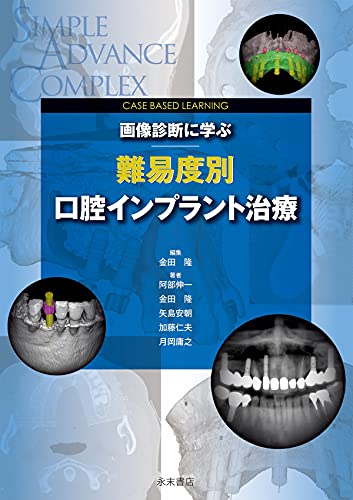- 著者
- 小松 知広 伊東 浩太郎 村岡 宏隆 平原 尚久 岡田 俊也 一木 俊吾 板倉 剛 金田 隆
- 出版者
- 特定非営利活動法人 日本歯科放射線学会
- 雑誌
- 歯科放射線 (ISSN:03899705)
- 巻号頁・発行日
- vol.60, no.2, pp.42-47, 2021 (Released:2021-04-01)
- 参考文献数
- 15
Background and Purpose: In recent years, a titanium-zirconium alloy(Ti-ZrO2)showing improved mechanical properties compared with commercially pure titanium(Ti)has been introduced. On magnetic resonance imaging(MRI), metal artifacts of dental implants often make diagnosis difficult in clinical situations. Therefore, it is very important to compare metal artifacts of Ti and Ti-ZrO2 dental implants using MRI. However, few studies have made this comparison. The purpose of this study was to investigate and compare metal artifacts of titanium and Ti-ZrO2 dental implants. Materials and Methods: The phantom used in this study was composed of a hollow cylinder with an outer diameter of 20.0cm, and a removable rod of 1.0cm in diameter was placed along the phantom’s central axis. Ti and Ti-ZrO2 alloy implants were placed on this rod. All subjects underwent imaging with a 1.5T MR scanner(Intera Achieva® 1.5T: Philips Medical Systems, Best, The Netherlands)with a SENSE head 8-channel coil. The imaging sequences included turbo spin echo(TSE)T1-weighted imaging(T1WI), TSE T2-weighted imaging(T2WI), short tau inversion recovery(STIR), and single shot echo planar imaging diffusion-weighted imaging(DWI). The full width at half maximum (FWHM) of metal artifact in each phase-encoding direction and frequency-encoding was measured on Image J. The Mann-Whitney U test was used to compare FWHM between Ti and Ti-ZrO2 implants. p-values less than 0.05 were considered to indicate significance. Results: The phase-encoding direction and frequency-encoding of FWHM were significantly different between Ti and Ti-ZrO2 implants on T2WI(p <0.01)and DWI(p< 0.05). There was no significant difference between each material on T1WI and STIR imaging. Conclusions: This study suggested that the Ti-ZrO2 implant is affected by metal artifacts less than the Ti implant on MRI.
1 0 0 0 転写因子OsNAC4によって誘導される過敏感細胞死の機構解析
- 著者
- 大坪 由佳 松井 弘善 多賀 有里 日比野 孝紀 金田 隆志 磯貝 彰 蔡 晃植
- 出版者
- 日本植物生理学会
- 雑誌
- 日本植物生理学会年会およびシンポジウム 講演要旨集
- 巻号頁・発行日
- vol.2010, pp.187, 2010
過敏感細胞死は、植物が非病原性菌株を認識したときに誘導される免疫反応の一つであり、核DNAの断片化や膜の透過性喪失などを伴うプログラム細胞死である。我々はこれまでに、イネの過敏感細胞死はOsNAC4によって誘導されることを明らかにした。そこで、OsNAC4による過敏感細胞死誘導の機構を明らかにすることを目的とし、過敏感細胞死誘導時のOsNAC4の局在について調べた。その結果、過敏感細胞死誘導時にOsNAC4はリン酸化されることで核に移行することが示された。また、このOsNAC4の核移行には、分子内のNACドメインのN末端とC末端の領域で制御されることが示された。次に、<I>OsNAC4</I>のRNAi形質転換体を用いたマイクロアレイ解析によって、OsNAC4が139個の遺伝子の発現を制御することが明らかになったので、OsNAC4による転写制御機構について調べた。まず、酵母two-hybrid法を用いてOsNAC4と相互作用するタンパク質の探索を試みたところ、同じサブファミリーに属するOsNAC3と相互作用することが確認された。そこで、OsNAC3が過敏感細胞死誘導に関与するかを一過的発現によって調べたところ、OsNAC3も過敏感細胞死を誘導することが明らかになった。以上の結果から、OsNAC4がOsNAC3と二量体を形成し、過敏感細胞死誘導に関与する遺伝子の発現を制御している可能性が示された。
1 0 0 0 基本から学ぶインプラントの画像診断
- 著者
- 金田隆編集 金田隆 [ほか] 著
- 出版者
- 砂書房
- 巻号頁・発行日
- 2008
1 0 0 0 画像診断に学ぶ難易度別口腔インプラント治療
- 著者
- 金田隆編 阿部伸一 [ほか] 著
- 出版者
- 永末書店
- 巻号頁・発行日
- 2014
1 0 0 0 一歩先のパノラマ診断力
- 著者
- 金田隆編 浅海淳一 [ほか] 著
- 出版者
- 砂書房
- 巻号頁・発行日
- 2012
1 0 0 0 尿路性器悪性腫瘍例における抹消血中ケラチン19mRNAの検出
- 著者
- 金田 隆志 星 宣次 毛 厚平 高橋 とし子 鈴木 謙一 佐藤 信 折笠 精一
- 出版者
- 社団法人日本泌尿器科学会
- 雑誌
- 日本泌尿器科學會雜誌 (ISSN:00215287)
- 巻号頁・発行日
- vol.89, no.1, pp.33-42, 1998-01-20
- 被引用文献数
- 2 1
(目的)健常者の抹消血液中にはケラチン19は存在せず、もし血液中から検出されれば上皮性癌細胞が存在しているものと考えられる。そこでnested RT-PCR法を用いて、種々の尿路性器悪性腫瘍患者の抹消血液からケラチン19 mRNAの発現の有無を検討し、転移との関連を検討した。(方法)ヒト尿路性器癌培養細胞12種類、泌尿生殖器担癌患者39例、健常者9例を対象とし、患者および健常者の抹消静脈から血液6mlを採血し、Ficillを用いてnested RT-PCRを行い、サザンブロッティングで確認した。(結果)用いた培養細胞は全て陽性で、検出率は健常者リンパ球1×10個に対して腎癌細胞TOS-1は1個の混入でもケラチン19 mRNAが検出され、膀胱癌細胞KK47では1×10^6個の混入ではじめてケラチン19 mRNAが検出された。健常者9例の抹消血は前例陰性であった。尿路性器悪性腫瘍患者の抹消血では転移のみられない症例よりも、転移を有する症例のほうがnested RT-PCRの陽性率が高く、またリンパ節のみの転移よりも他の遠隔転移を有する症例のほうが陽性率が高かった。また、短期間の観察であるが、転移の有する場合でもnested RT-PCR陽性のほうが予後不良であった。疾患例では、精巣腫瘍は検出されにくく陰茎癌は検出されやすい印象であった。(結論)RT-PCR法を用いたケラチン19 mRNAの抹消血よりの検出法は尿路性器腫瘍にも利用できる。


